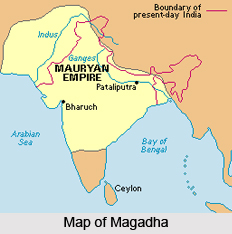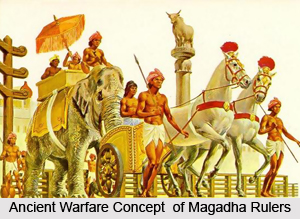 History says that one of the earliest and most famous kings of Magadha was Jarasandha of epic fame. The Mahabharata speaks of Jarasandha, son of King Brhadratha, as a very great and powerful king of Magadha who reigned in the city of Girivraja or Rajagriha. It has been said in the Bhagavata Purana narrates that Bhima, Arjuna, and Krishna went to Girivraja where Bhima killed Jarasandha, and Krishna made Sahadeva king of Magadha, and released all the kings imprisoned by Jarasandha.
History says that one of the earliest and most famous kings of Magadha was Jarasandha of epic fame. The Mahabharata speaks of Jarasandha, son of King Brhadratha, as a very great and powerful king of Magadha who reigned in the city of Girivraja or Rajagriha. It has been said in the Bhagavata Purana narrates that Bhima, Arjuna, and Krishna went to Girivraja where Bhima killed Jarasandha, and Krishna made Sahadeva king of Magadha, and released all the kings imprisoned by Jarasandha.
History says that Bimbisara was appointed the king of Magadha at the age of fifteen and he had ruled the kingdom for a period of 52 years. King Bimbisara had annexed Anga to his kingdom of Magadha. Anga was a small kingdom to the east, corresponding to the modern district of Bhagalpur. The annexation of Anga was the turning point in the history of Magadha. In fact it can be said that in the history of Magadha Bimbisara was considered real founder of the Magadhan imperial power. He strengthened his position by matrimonial alliances with the two neighbouring states, viz. Kosala and Vaishali.
Thus the marriages of Bimbisara paved the way for the expansion of Magadha both westward and northward, and enabled Bimbisara to add a part of Kasi to his dominions and to launch Magadha on that career of conquest and aggrandisement which only ended when Ashoka sheathed his sword after the conquest of Kalinga.
Ajatashatru had succeeded Bimbisara as the ruler of Magadha. Ajatasatru suffered the same miserable fate as his father, being put to death by his son Udayi Bhadda. According to the genealogical lists given in the Puranas, Ajatashatru was succeeded by Darsaka. Some historical says that Ajatashatru was succeeded by hi son Aniruddha as the king of Magadha. After this the Nandas had succeeded the throne of Magadhas and had ruled for a period of 22 years. According to the Puranas, the founder and first king of the Nanda dynasty was Mahapadma Nanda, son of Mahanandin by a Sudra woman. He had usurped the throne of Magadha in or about 413 B.C.
 The historical account says that that the Nanda dynasty was overthrown by Chandragupta Maurya with the help of his wily and astute minister, Kautilya. It can be said that Magadha which, before Bimbisara was merely a tiny state in South Bihar, had, during the interval from the time of Bimbisara to the Kalinga war of Ashoka, expanded to a gigantic empire from the foot of the Hindu Kush to the borders of the Tamil country. After the Kalinga war, the political destiny of Magadha had reversed. The empire gradually became smaller and smaller till it sank to its pre-Bimbisarian area and position.
The historical account says that that the Nanda dynasty was overthrown by Chandragupta Maurya with the help of his wily and astute minister, Kautilya. It can be said that Magadha which, before Bimbisara was merely a tiny state in South Bihar, had, during the interval from the time of Bimbisara to the Kalinga war of Ashoka, expanded to a gigantic empire from the foot of the Hindu Kush to the borders of the Tamil country. After the Kalinga war, the political destiny of Magadha had reversed. The empire gradually became smaller and smaller till it sank to its pre-Bimbisarian area and position.
The kingdom of Magadha had been ruled by the Sunga Dynasty, the Kanva Dynasty and a lot more. It has been mentioned that at the beginning of the fourth century A.D. the Magadhan monarchy again rose into prominence under the Guptas. Chandragupta had ascended the throne in 320 A.D., the initial date of the Gupta era. Like Bimbisara he had also strengthened his position by a matrimonial alliance with the Licchavis of Vaisali, who appear to have continued to occupy an influential position in North India.
After Chandragupta II, the Gupta power in Magadha was temporarily eclipsed by the Pusyamitras. Then followed the Huna invasion, in which the Emperor Skandagupta, was presumably victorious, and, was unable to continue the successful resistance which he had offered in the earlier days of his rule, and was forced at last to succumb to the repeated attacks of the foreigners.
But the Magadhan Empire did not wholly perish on the death of Skandagupta. It was ruled by Puragupta, Narasirnhagupta, Kumaragupta II, and Buddhagupta. History narrates that in the first half of the seventh century, Harsa, the great Kanouj monarch had overshadowed the Gupta power, which was revived by Adityasena, who assumed the titles of Paramabhattakara.
After this the throne of Magadha was occupied by a Gauda king named Gopala Then the great Magadhan empire decayed politically, being included in the Gauda empire of the Palas and Senas, but it continued to remain the centre and headquarters of Buddhist learning up to the time of the Muhammadan conquests at the close of the twelfth century, when the monasteries with their well-stocked libraries were reduced to ashes.



















